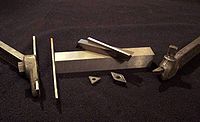
Photo from wikipedia
The performance of a self-propelled rotary carbide tool when cutting hardened steel is evaluated in this study. Although various models for evaluating tool wear in traditional (fixed) tools have been… Click to show full abstract
The performance of a self-propelled rotary carbide tool when cutting hardened steel is evaluated in this study. Although various models for evaluating tool wear in traditional (fixed) tools have been introduced and deployed, there have been no efforts in the existing literature to predict the progression of tool wear while employing self-propelled rotary tools. The work-tool geometric relationship and the empirical function are used to build a flank wear model for self-propelled rotary cutting tools. Cutting experiments are conducted on AISI 4340 steel, which has a hardness of 54–56 HRC, at various cutting speeds and feeds. The rate of tool wear is measured at various intervals of time. The constant in the proposed model is obtained using genetic programming. When experimental and predicted flank wear are examined, the established model is found to be competent in estimating the rate of rotary tool flank wear progression.
Journal Title: Materials
Year Published: 2022
Link to full text (if available)
Share on Social Media: Sign Up to like & get
recommendations!